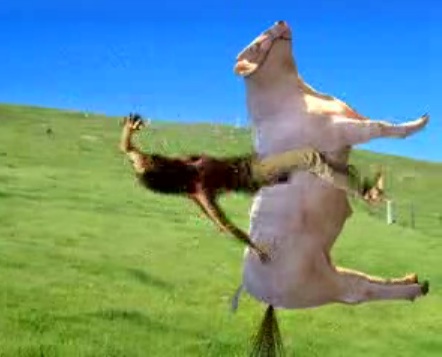Chef and restaurateur Lenny Russo joins other food pornographers such as Mark Bittman and Nina Planck in promoting fashion over facts by recycling the claim that grass-fed cattle have significantly lower levels of dangerous E. coli than grain-fed cattle.
Mike Osterholm, director of the Center for Infectious Disease Research and Policy and professor in the School of Public Health at the University of Minnesota and Russo’s target, does a nice job of, um, crushing Russo’s assertions in today’s Minneapolis-St. Paul Star Tribune:
 "Russo cited conclusions from a 1998 study from Cornell University that cattle fed a diet of grass, not grain, had very few E. coli, and that those bacteria that survived in the cattle feces would not survive in the human when eaten in undercooked meat, particularly hamburger. This statement is based on a study of only three cows rotated on different diets and for which the researchers did not even test for E. coli O157:H7. Unfortunately, the authors extrapolated these incredibly sparse results to the entire cattle industry. The Cornell study is uncorroborated in numerous published scientific papers from renowned research groups around the world. Finally, work conducted by the Minnesota Department of Health as part of a national study on foodborne disease recently showed that eating red meat from local farms was a significant risk factor for E. coli infection. …
"Russo cited conclusions from a 1998 study from Cornell University that cattle fed a diet of grass, not grain, had very few E. coli, and that those bacteria that survived in the cattle feces would not survive in the human when eaten in undercooked meat, particularly hamburger. This statement is based on a study of only three cows rotated on different diets and for which the researchers did not even test for E. coli O157:H7. Unfortunately, the authors extrapolated these incredibly sparse results to the entire cattle industry. The Cornell study is uncorroborated in numerous published scientific papers from renowned research groups around the world. Finally, work conducted by the Minnesota Department of Health as part of a national study on foodborne disease recently showed that eating red meat from local farms was a significant risk factor for E. coli infection. …
 "Russo would understand this issue in an entirely different light if he had been with me when I had to explain to distraught parents that their young daughter’s death was due to eating an undercooked hamburger, prepared by them, and the E. coli that caused her illness came from meat from a cow raised only on pasture grass and processed by the local meat packer. The cow also came from Grandpa’s farm down the road."
"Russo would understand this issue in an entirely different light if he had been with me when I had to explain to distraught parents that their young daughter’s death was due to eating an undercooked hamburger, prepared by them, and the E. coli that caused her illness came from meat from a cow raised only on pasture grass and processed by the local meat packer. The cow also came from Grandpa’s farm down the road."
Lawyer Bill Marler offered his own take on the exchange, so I’ll jump in to reiterate that the natural reservoirs for E. coli O157:H7 and other verotoxigenic E. coli is the intestines of all ruminants, including cattle — grass or grain-fed — sheep, goats, deer and the like. The final report of the fall 2006 spinach outbreak identifies nearby grass-fed beef cattle as the likely source of the E. coli O157:H7 that sickened 200 and killed 4.
As my colleague David Renter wrote in Sept. 2006,
"Cattle raised on diets of ‘grass, hay and other fibrous forage’ do contain E. coli O157:H7 bacteria in their feces as do other animals including deer, sheep, goats, bison, opossum, raccoons, birds, and many others.
"Cattle diet can affect levels of E. coli O157:H7, but this is a complex issue that has been and continues to be studied by many scientists. To suggest switching cattle from grain to forage based on a small piece of the scientific evidence is inappropriate and irresponsible. Several pieces of evidence suggest that such a change would not eliminate and may even increase E. coli O157:H7 in cattle.
"The current spinach outbreak may be traced back to cattle manure, but there are many other potential sources. Simplistically attacking one facet of livestock production may be politically expedient, but instead provides a false sense of security and ignores the biological realities of E. coli O157:H7. In 1999, for example, 90 children were felled by E. coli O157:H7 at a fair in London, Ont. The source? A goat at a petting zoo, hardly an intensively farmed animal."
Images courtesy of the IFSN video Poop in the Field, available at http://www.youtube.com/watch?v=IL8iXUbTqgI
